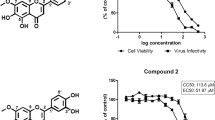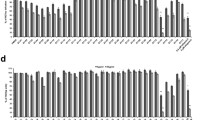Abstract
Background and aims
Chronic hepatitis C virus (HCV) infection is a major cause of liver disease worldwide. Although direct-acting antivirals can cure the large majority of treated patients, important limitations remain, including treatment failure and high costs precluding access to therapy in resource-limited settings. We report herein the anti-HCV effects of IND02, a procyanidin type A molecule, isolated and characterized from cinnamon.
Methods and results
Using cellculture-derived HCV (HCVcc), HCV pseudoparticles (HCVpp), and subgenomic replicons, we demonstrated that IND02 markedly and dose-dependently inhibited HCV cell entry. Kinetic assays demonstrated that IND02 inhibits HCV entry most likely at a postbinding step. Experiments performed using primary human hepatocytes confirmed inhibition of HCV entry by IND02, demonstrating the functional impact in the most physiological cell-based system for studying HCV–host interactions.
Conclusions
The natural compound IND02 exhibits potent HCV cell entry inhibition and provides a novel perspective for development of a low-cost antiviral for treatment of HCV infection.



Similar content being viewed by others
Abbreviations
- HCV:
-
Hepatitis C virus
- LT:
-
Liver transplantation
- EGCG:
-
(−)-Epigallocatechin-3-gallate
- HCVcc:
-
Cellculture-derived HCV
- HCVpp:
-
HCV pseudoparticles
- VSV:
-
Vesicular stomatitis virus
- TCID50 :
-
50 % tissue culture infective dose
- PHH:
-
Primary human hepatocytes
- EC50 :
-
50 % effective concentration
- nAbs:
-
Neutralizing antibodies
References
Joshi D, Pinzani M, Carey I, Agarwal K. Recurrent HCV after liver transplantation-mechanisms, assessment and therapy. Nat Rev Gastroenterol Hepatol 2014;11(12):710–721
Chung RT, Baumert TF. Curing chronic hepatitis C-the arc of a medical triumph. N Engl J Med 2014;370(17):1576–1578
Pawlotsky JM, Feld JJ, Zeuzem S, Hoofnagle JH. From non-A, non-B hepatitis to hepatitis C virus cure. J Hepatol 2015;62(1):S87–S99
Roche B, Coilly A, Roque-Afonso AM, Samuel D. Interferon-free hepatitis C treatment before and after liver transplantation: the role of HCV drug resistance. Viruses 2015;7(9):5155–5168
Ferenci P. Treatment of hepatitis C in difficult-to-treat patients. Nat Rev Gastroenterol Hepatol 2015;12(5):284–292
Calland N, Dubuisson J, Rouille Y, Seron K. Hepatitis C virus and natural compounds: a new antiviral approach? Viruses 2012;4(10):2197–2217
Blaising J, Levy PL, Gondeau C, Phelip C, Varbanov M, Teissier E, et al. Silibinin inhibits hepatitis C virus entry into hepatocytes by hindering clathrin-dependent trafficking. Cell Microbiol 2013;15(11):1866–1882
Ciesek S, von Hahn T, Colpitts CC, Schang LM, Friesland M, Steinmann J, et al. The green tea polyphenol, epigallocatechin-3-gallate, inhibits hepatitis C virus entry. Hepatology 2011;54(6):1947–1955
Calland N, Sahuc ME, Belouzard S, Pene V, Bonnafous P, Mesalam AA, et al. Polyphenols inhibit hepatitis C virus entry by a new mechanism of action. J Virol 2015;89(19):10053–10063
Lu T, Sheng H, Wu J, Cheng Y, Zhu J, Chen Y. Cinnamon extract improves fasting blood glucose and glycosylated hemoglobin level in Chinese patients with type 2 diabetes. Nutr Res 2012;32(6):408–412
Frydman-Marom A, Levin A, Farfara D, Benromano T, Scherzer-Attali R, Peled S, et al. Orally administrated cinnamon extract reduces beta-amyloid oligomerization and corrects cognitive impairment in Alzheimer’s disease animal models. PLoS One 2011;6(1):e16564
Cabello CM, Bair WB, Lamore SD, Ley S, Bause AS, Azimian S, et al. The cinnamon-derived Michael acceptor cinnamic aldehyde impairs melanoma cell proliferation, invasiveness, and tumor growth. Free Radic Biol Med 2009;46(2):220–231
Connell BJ, Chang SY, Prakash E, Yousfi R, Mohan V, Posch W, et al. A cinnamon-derived procyanidin compound displays anti-HIV-1 activity by blocking heparan sulfate- and co-receptor- binding sites on gp120 and reverses T cell exhaustion via impeding tim-3 and PD-1 upregulation. PLoS One 2016;11(10):e0165386
Lin WL, Guu SY, Tsai CC, Prakash E, Viswaraman M, Chen HB, et al. Derivation of cinnamon blocks leukocyte attachment by interacting with sialosides. PLoS One 2015;10(6):e0130389
Lupberger J, Zeisel MB, Xiao F, Thumann C, Fofana I, Zona L, et al. EGFR and EphA2 are host factors for hepatitis C virus entry and possible targets for antiviral therapy. Nat Med 2011;17(5):589–595
Krieger SE, Zeisel MB, Davis C, Thumann C, Harris HJ, Schnober EK, et al. Inhibition of hepatitis C virus infection by anti-claudin-1 antibodies is mediated by neutralization of E2-CD81-claudin-1 associations. Hepatology 2010;51(4):1144–1157
Braun DL, Rauch A, Aouri M, Durisch N, Eberhard N, Anagnostopoulos A, et al. A lead-in with silibinin prior to triple-therapy translates into favorable treatment outcomes in difficult-to-treat HIV/hepatitis C coinfected patients. PLoS One 2015;10(7):e0133028
Pietschmann T, Kaul A, Koutsoudakis G, Shavinskaya A, Kallis S, Steinmann E, et al. Construction and characterization of infectious intragenotypic and intergenotypic hepatitis C virus chimeras. Proc Natl Acad Sci USA 2006;103(19):7408–7413
Stamataki Z, Coates S, Evans MJ, Wininger M, Crawford K, Dong C, et al. Hepatitis C virus envelope glycoprotein immunization of rodents elicits cross-reactive neutralizing antibodies. Vaccine 2007;25(45):7773–7784
Fofana I, Fafi-Kremer S, Carolla P, Fauvelle C, Zahid MN, Turek M, et al. Mutations that alter use of hepatitis C virus cell entry factors mediate escape from neutralizing antibodies. Gastroenterology 2012;143(1):223–233
Pestka JM, Zeisel MB, Blaser E, Schurmann P, Bartosch B, Cosset FL, et al. Rapid induction of virus-neutralizing antibodies and viral clearance in a single-source outbreak of hepatitis C. Proc Natl Acad Sci USA 2007;104(14):6025–6030
Lindenbach BD, Evans MJ, Syder AJ, Wolk B, Tellinghuisen TL, Liu CC, et al. Complete replication of hepatitis C virus in cell culture. Science 2005;309(5734):623–626
Zeisel MB, Koutsoudakis G, Schnober EK, Haberstroh A, Blum HE, Cosset FL, et al. Scavenger receptor class B type I is a key host factor for hepatitis C virus infection required for an entry step closely linked to CD81. Hepatology 2007;46(6):1722–1731
Fauvelle C, Felmlee DJ, Crouchet E, Lee J, Heydmann L, Lefevre M, et al. Apolipoprotein E mediates evasion from hepatitis C virus neutralizing antibodies. Gastroenterology 2016;150(1):206–217
Acknowledgements
The authors thank F. Chisari (The Scripps Research Institute, La Jolla, CA) for the gift of Huh7.5.1 cells, T. Wakita (Department of Virology II, National Institutes of Health, Tokyo, Japan), C. M. Rice (Rockefeller University, New York, NY) for providing HCV strain JFH1, and R. Bartenschlager (University of Heidelberg, Heidelberg, Germany) for HCV strain Luc-Jc1 and VL:JFH1. The authors thank P. Pessaux (Strasbourg University Hospitals) for liver resection to isolate PHH. The authors thank Eric Soulier for technical assistance in PHH experiments and HCV RT-PCR, and Dr. Luzia Mayr and Dr. Mirjam Zeisel for helpful discussions and support in manuscript editing.
Author information
Authors and Affiliations
Contributions
Author contributions
M.L., C.F., C.M., and T.F.B. wrote the manuscript. M.L., C.F., E.P., C.M., and T.F.B. designed experiments. M.L., C.F., and L.H. performed experiments. M.L., C.F., L.H., C.M., and T.F.B. analyzed data. E.P. and B.S. provided reagents. M.V. isolated and purified IND02. C.M. and T.F.B. directed the project.
Corresponding authors
Ethics declarations
Conflict of interest
The authors disclose the following: E. Prakash, S. Bhaskaran, and M. Vishwaraman are employed by Indus Biotech. Authors C. Fauvelle, M. Lambotin, L. Heydmann, T. F. Baumert, and C. Moog declare no conflicts. Part of the research was funded by Indus Biotech Pvt Ltd, but this sponsor had no impact on experimental design or data analyses.
Ethical approval
Liver tissue from patients undergoing surgical resection for isolation of human hepatocytes was obtained with informed consent from all patients. The protocol was approved by the Ethics Committee of the University of Strasbourg Hospitals (CPP 10-17).
Funding information
This work was supported by Dormeur Investment Service Ltd. and Indus Biotech Pvt ltd. M.L. was supported by the European Community’s Seventh Framework Programme (FP7/2007-2013; EuroNeut41).
Rights and permissions
About this article
Cite this article
Fauvelle, C., Lambotin, M., Heydmann, L. et al. A cinnamon-derived procyanidin type A compound inhibits hepatitis C virus cell entry. Hepatol Int 11, 440–445 (2017). https://doi.org/10.1007/s12072-017-9809-y
Received:
Accepted:
Published:
Issue Date:
DOI: https://doi.org/10.1007/s12072-017-9809-y




